
~~~~~~~~~~~~~~~~~~~~~~~~~~~~~~~~~~~~~~~~~~~
Live Earth Farm (Com)Post
19th Harvest Week, Season 12
August 6th - 12th, 2007
~~~~~~~~~~~~~~~~~~~~~~~~~~~~~~~~~~~~~~~~~~~
(click here for a pdf of the paper
version of this newsletter)
In this issue
--Greetings from Farmer Tom
--Member Quote of the Week
--Live Earth Farm Kids
--Mataganza Garden Sanctuary Internship Program
--Egg Share update
--Pictures around the farm
--What's in the box this week
--Notes from Debbie's Kitchen
--Calendar
--Contact Information
" One of the most rewarding things about farming
and eating with the seasons is the anticipation it provides."
~ Thomas Broz (aka 'Farmer Tom')
Greetings from Farmer Tom
~~~~~~~~~~~~~~~~~~~~~~~~~~~~~~~~~~~~~~~~~~~~~~~~
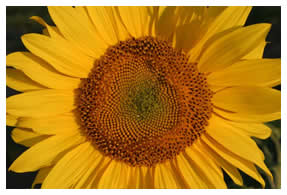 If the farm's workload were to be compared to an orchestral performance,
we are currently performing the most brisk and liveliest of Vivaldi's “Four Seasons” – Summer.
It’s not easy, even for an experienced and well-seasoned player, to maintain
Summer's demanding tempo. The tempo of each season is not so much about the speed
in which tasks have to be accomplished, but rather how one relates to the overall
rhythm, the basic beat, of the farm. Each season has its own tempo, some faster
some slower, and as long as that tempo is in harmony with the rhythm of the farm,
one finds a fulfilling satisfaction.
If the farm's workload were to be compared to an orchestral performance,
we are currently performing the most brisk and liveliest of Vivaldi's “Four Seasons” – Summer.
It’s not easy, even for an experienced and well-seasoned player, to maintain
Summer's demanding tempo. The tempo of each season is not so much about the speed
in which tasks have to be accomplished, but rather how one relates to the overall
rhythm, the basic beat, of the farm. Each season has its own tempo, some faster
some slower, and as long as that tempo is in harmony with the rhythm of the farm,
one finds a fulfilling satisfaction.In summer the tempo is alegro (happy) – life all around us expresses a mature and diverse abundance, like a crescendo that has been building since the start of Spring. Each crop has its unique rhythm and life cycle, and its own particular character. Radishes and most leafy greens are fast and short lived; carrots and beets are steady and reliable; lush crucifers such as broccoli, cabbage and cauliflower like it cool and are generally hungry and thirsty. Potatoes, unless planted early, are prone to sickness and disease; and in the vegetable kingdom, none gets more attention during the summer season as does the Tomato... the "grand dame" of the nightshades, courted of course by her relatives the Peppers and Eggplants.
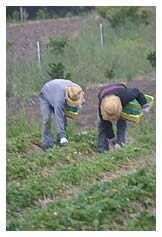 Live
Earth Farm's green beans and strawberries are probably the most popular, and
have developed into cornerstones whose performance usually determines the overall
financial health of the farm. They also demand the most labor and physical exertion,
requiring hours of stooping, backs bent, to reap their benefit. In the last few
years the caneberries (blackberries and raspberries) have also carved out an
increasingly import niche, and typically are less exhausting to harvest than
strawberries and green beans due to their upright and more perennial nature.
Live
Earth Farm's green beans and strawberries are probably the most popular, and
have developed into cornerstones whose performance usually determines the overall
financial health of the farm. They also demand the most labor and physical exertion,
requiring hours of stooping, backs bent, to reap their benefit. In the last few
years the caneberries (blackberries and raspberries) have also carved out an
increasingly import niche, and typically are less exhausting to harvest than
strawberries and green beans due to their upright and more perennial nature.One of the biggest challenges of operating a CSA farm is maintaining continuity and abundance in the harvest throughout the season. This requires a keen sense of timing in planting of the successions of crops. For example, green beans are planted up to 20 times throughout the season between early April and end of August in order to maintain a continuous harvest. Planting intervals vary depending on day length – from every 8 days to every 3-4 days as the days grow shorter by the end of August. Successional plantings not only need to fit natural variables such as soil moisture, temperature, and day length, but also need to synchronize with the timing, field rotations and the unique physiological and cultural growing habits of all the other crops. Experimenting from year to year has helped me to identify which specific vegetable varieties perform better in the varying soil types and microclimates of the 5 different fields we farm. And the advantage of this combined knowledge of vegetable varieties and soil/microclimates is the ability to extend our growing season (or at least the growing season of particular crops).
Perfecting all these techniques is important for keeping up with the tempo of each season. But even more important for all who work and live here on the farm is the ability to stay connected to the same rhythm; otherwise, there is no joy in playing the seasonal music at all.
For me one of the most important crescendos of the summer season is the harvest of our Warren pears. This year, the combined effects of hand-pollination and favorable spring weather has developed into one of the most promising and abundant pear crops ever. The time is almost upon us to pick them off the trees. The sugar levels (like the brix of wine grapes), the color and the size are reaching their optimum stage and I expect we will start with a selective harvest this week. Because of the size of the crop this year, we'll be picking the largest and ripest fruit first, and then pausing 1 to 2 weeks before picking the rest of the crop, leaving the smaller fruit on the trees until they reach their optimal level of maturity. By spreading the harvest out over a couple of weeks we hope to not feel quite so overwhelmed by the already accelerated tempo of this bountiful crescendo, as we turn the corner of the summer season and head towards fall. - Tom
The Warren pear 'crescendo'...
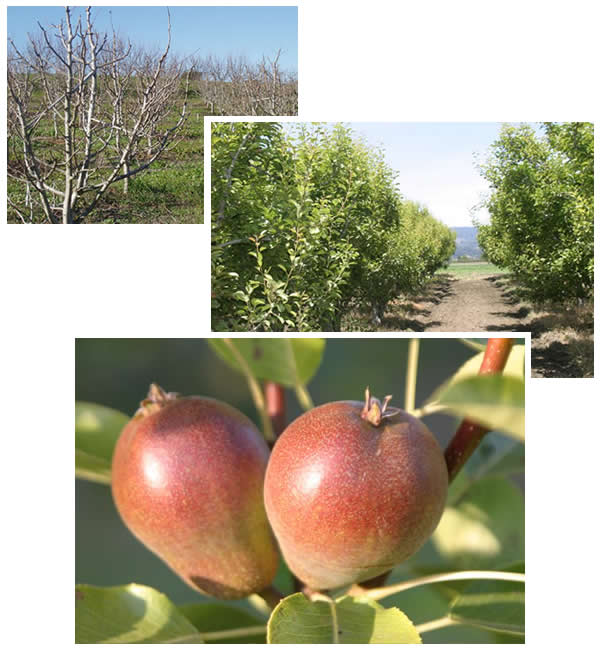
<back to top>
Member Quote of the Week
~~~~~~~~~~~~~~~~~~~~~~~~~~~~~~~~~~~~~~~~~~~~~~~~
This is from member Molly Tierney, in her farewell to the farm (she and her family
are moving away, and so reluctantly must give up their CSA share): “It's
been so great. I can't say enough. The thrill we get each week getting our share
and fruit and eggs and goat milk... my five year old now chooses the veggies
from the weekly share that he wants to make in his own stir-fry to contribute
to the family dinner. And the color of those egg yolks! And how we have
to count out a share of the berries for my husband each Wednesday so he'll get
some when he comes home from work. Oh we're going to miss you folks. Thanks for
a wonderful season.”
<back to top>
Live Earth Farm Kids
~~~~~~~~~~~~~~~~~~~~~~~~~~~~~~~~~~~~~~~~~~~~~~~~
 Email your favorite “LEF Kid” pictures along with short story or
caption to deb@writerguy.com. Here’s this week picture, from member Alexis
Schassberger, who says, “I just took this picture of our son trying beets
(from the farm, of course) for the first time. He absolutely loved them!
Email your favorite “LEF Kid” pictures along with short story or
caption to deb@writerguy.com. Here’s this week picture, from member Alexis
Schassberger, who says, “I just took this picture of our son trying beets
(from the farm, of course) for the first time. He absolutely loved them!
<back to top>
Mataganza Garden Sanctuary Internship Program
~~~~~~~~~~~~~~~~~~~~~~~~~~~~~~~~~~~~~~~~~~~~~~~~
Brian Barth still has openings in this six-week program. Anyone interested in
participating, or just curious about it can click
here to read more about it. First week of the program is this coming Friday,
August 10th, so act quickly if you'd like to participate! Brian’s
contact information is: phone – 831.566.3336
email – edenfruits2002@yahoo.com
<back to top>
Egg Share Update
~~~~~~~~~~~~~~~~~~~~~~~~~~~~~~~~~~~~~~~~~~~~~~~~
a letter from Jim Dunlop of TLC Ranch (our egg share provider)
Hi Tom and Debbie – I
just wanted to drop you a line and give you a long overdue update on what is
going on here at TLC Ranch. The hens are laying pretty steady. This time of year
I start seeing a slow drop in production that continues until the shortest days
of the year in December. The hens are having to travel a little further to find
green grass during these dry days of August, but there is still plenty to be
had, and they are putting the smack down on my attempts to establish irrigated
pasture near their current stomping grounds. I am feeding them organic layer
pellets and scratch grains, plus several tons of heirloom tomatoes, melons, greens,
onions and other vegetables each week – all organic. [When not out
on pasture] they are living in two 8 by 30 foot cotton trailer chicken houses,
and they have a couple of other shelters as well, where they can drink water,
lay eggs and hide from hawks. The cotton trailers have provided the starting
point for the best chicken shelters I have made so far, and I am 100% pleased
with their performance. I am going to get another 5 cotton trailers from
the Central Valley in the coming weeks and convert them to chicken and pig
shelters. [Jim raises pastured pigs as well as chickens. - Debbie] Predation
on the chickens is negligible now that I have a guard dog. Buying a livestock
guard dog has been one of my best investments so far. I recently started
irrigating my pastures with two big gun impact sprinklers. I am able to
irrigate almost two acres at a time with this system. As I learn how to
maximize their effectiveness over the next year, I will be able to produce
a lot more of my feed and forage here on the farm. For me and my farm business,
this is more important than ever, as feed prices continue to skyrocket with
no end in sight. This price increase is the direct result of the current
ethanol craze. The rising price of corn has caused the price of every form
of feed and forage to rise as well. Please pass on
my thanks to all of your members who are getting an egg share. Since
I'm a one-man show, marketing my eggs through Live Earth Farm’s CSA
has turned out to be a real winner. Thanks - Jim
<back to top>
Pictures around the farm
~~~~~~~~~~~~~~~~~~~~~~~~~~~~~~~~~~~~~~~~~~~~~~~~
Some images from Summer's symphony on the farm: dry-farmed tomatoes...
a field of arugula... our succulent golden raspberries...
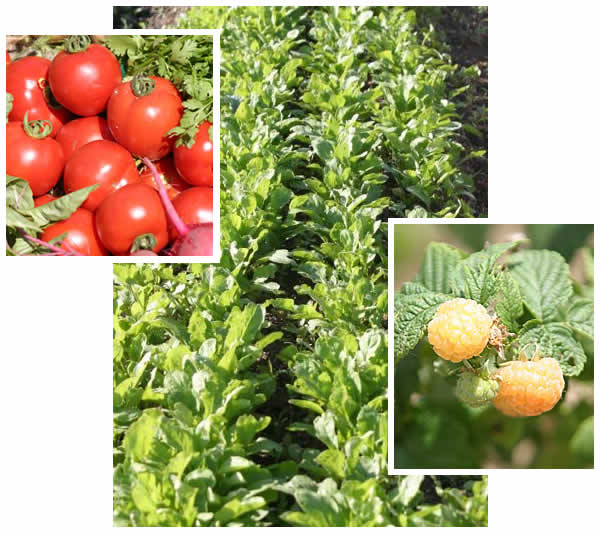
dewy broccolini... crisp carrots...
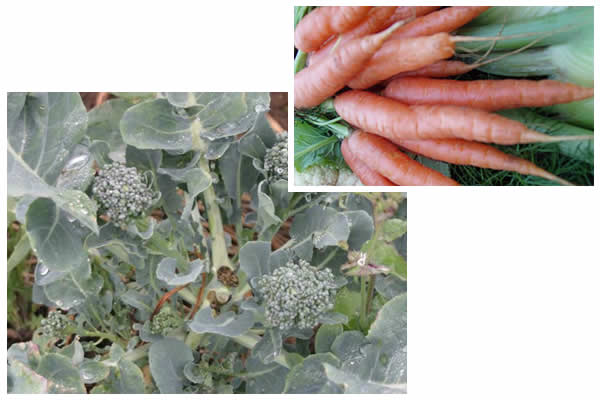
a prime green bean, ready to be picked... some mei qing choi in the
field... and a beautiful array of beets, including the
dark cylindrical 'Bull's Blood', the pink chioggia, and the rich, sweet
golden beets.
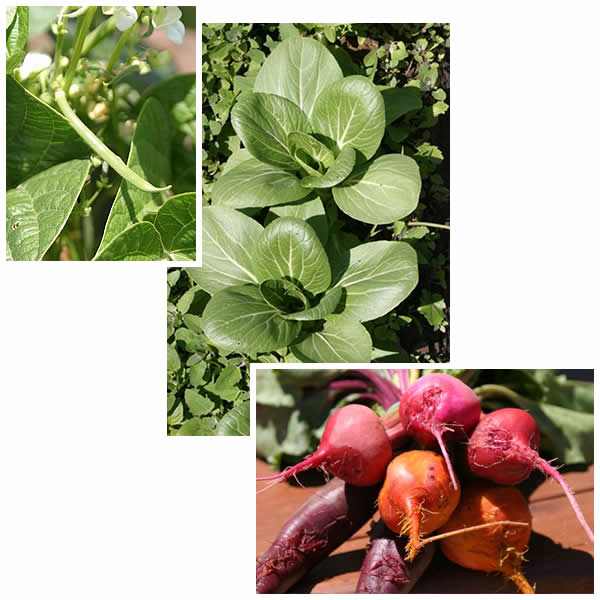
<back to top>
What's in the box this week
~~~~~~~~~~~~~~~~~~~~~~~~~~~~~~~~~~~~~~~~~~~~~~~~
Content differences between Family and Small
Shares are underlined and italicized; items with a “+” in
Family Shares are more in quantity than in Small; anticipated quantities are
in parentheses. Occasionally the content of your share will differ from what's
on this list, but we do our best to give you an accurate projection.
Family Share:
Arugula +
Basil
Beets
Broccolini +
Carrots
Chard or kale
Leeks
Lettuce +
Mei qing choi +
Bag of mixed peppers and eggplant
Summer squash +
Heirloom and dry-farmed tomatoes
Cherry tomatoes
Strawberries (2 baskets)
Small Share:
Arugula
Basil
Broccolini
Carrots
Chard or kale
Leeks
Lettuce
Mei qing choi
Potatoes
Summer squash
Heirloom and dry-farmed tomatoes
Cherry tomatoes
Strawberries (1 basket)
Extra Fruit Option:
2 baskets of strawberries, plus 1 basket each of blackberries and raspberries
"Strawberry Bounty" Option:
-- stopped for now; will resume with next strawberry flush! --
<back to top>
Notes from Debbie's Kitchen
~~~~~~~~~~~~~~~~~~~~~~~~~~~~~~~~~~~~~~~~~~~~~~~~
Click
here to go to my extensive
recipe database, spanning 10 years of CSA recipes and alphabetized
by key ingredient. Includes photos of most farm veggies; helpful for
ID-ing things in your box! Also, FYI, as a rule, I put my own comments
within recipes that are not my own inside square brackets [like this]
to distinguish them from the voice of the recipe-writer.
This week, Alie and Bruce Victorine share their experiences as
first-time members (new this season!) and how they would go about using
this week's bounty. - Debbie
What We'd do with This Week's Box
By Bruce and Alie Victorine
This is our first season enjoying the box, and it is has been delightful
developing new routines and discovering new habits in our culinary lives.
When we get the box, we follow all of Debbie’s wonderful suggestions for
storing the veggies and fruit. One of our habits has become to put a large bowl
in the sink as we wash the leafy greens and scrub the carrots. We then use the
water in the bowl to give our garden a drink. Feels good to conserve in our dry
year, and it’s amazing to see how many gallons of water the process can
take. Even though we live in a condo, we vermicompost, so all the unusable parts
go out to the worms. But other parts – trimmings and such, like the ends
of carrots, kale stalks, and tops of onions – go into a bag in the freezer.
Bruce uses all these to make veggie or chicken broth when the mood strikes.
It’s just the two of us, so one of our new habits has become cooking something
and freezing it for later. And because we are both busy, when we cook we will
often make a few things at a time.
So this week we know that we will be baking Zucchini-Carrot
Muffins that we take for our “on the go” breakfast. The summer
squash works just fine. We’ve also discovered that apricot jam is a
good substitute for the orange marmalade in the recipe. We often make a double
batch and freeze one for the following week.
Since the food processor is in use, we’ll grate extra carrots, squash,
or beets to expedite salad making during the week. Store them separately
in airtight containers. Or we might make a quick carrot/squash slaw that will
keep for a few days:
| Carrot and Summer Squash Slaw 1 C grated carrot 1 C grated summer squash 1 – 2 tsp. vegetable oil Juice of one lime ~ ¼ to ½ tsp. (+ or -) chili powder Mix all together. The chili should just give a tang with out being overpowering. So start with a little and taste as you go. Parsley or cilantro would be a good addition to this slaw. |
Another new habit is making appetizers that we can freeze and reheat later. Two of our favorites are muffin size Citrus Feta Beet Quiche and Greens in Phyllo. This week we’ll use the chard or kale and the leeks to make this yummy dish:
| Greens in Phyllo In olive oil, sauté some onion, garlic, or leeks. Add thinly chopped dark greens such as kale or chard (or spinach) and sauté until just tender. Don’t over cook! Layer 4 sheets of phyllo dough, using a combo of olive oil and butter (follow the directions on the frozen phyllo dough for layering.) Spread the greens mixture on the dough and roll up like a burrito. I usually make 3 to 4. Wrap in aluminum foil and freeze up to 2 weeks. When ready to serve, partially slice into 4 to 5 sections, bake in a hot oven until brown (425F, I think but follow directions on pkg.). Slice the rest of the way and serve. |
Okay enough about cooking ahead. What are we going to cook and eat right away?
For a bit of a southern style meal, Bruce will either roast a chicken or pan “fry” some thin chicken breasts. We’ll also cook up a batch of Noah Thompson's Zucchini Fritters using the summer squash. Alie will use the chicken drippings, plus real butter and olive oil to make a delicious gravy. Slice a large, meaty tomato and keep it in the fridge until ready to serve. Now pour that hot gravy on that cold tomato and enjoy!!! ‘Gravy on tomatoes?’ you say? Not only does it taste great, check out this blurb about lycopene in tomatoes from RealAge.com (note in particular item 2):
| 3 Ways to Unload More Lycopene For those of us noshing on red tomatoes, here are three tricks to unleash their lycopene: 1) Slice, dice, or puree them. Processing tomatoes helps unleash the lycopene. 2) Eat them with a bit of fat. Lycopene must latch on to fat (so you might as well make it healthy, like olive oil) to be absorbed by the intestinal wall. 3) Heat ’em up. Heat converts the lycopene in red tomatoes into a form that’s easier for your body to absorb. |
The following salad would go well with that meal:
| Beet Apple Salad with Horseradish Dressing (Betty Ann’s) ½ C (+ or -) red onion diced 2 apples, chopped into bite-sized chunks 5-6 cooked beets (steamed or roasted), chopped Dressing: 1 shallot minced 1 tsp. Dijon mustard 1 tsp. horseradish 2 tsp. red wine vinegar ¼ tsp. celery seed ¼ tsp. salt 2 tbsp. vegetable oil 2 tbsp. olive oil Pepper Toss all together and let stand at least 15 minutes. As with all salads of this type, it gets better as it marinates. To serve, sprinkle with chopped fresh dill and or scallions. |
One more new habit we have developed: kale for breakfast! On the weekends, Bruce poaches or fries a few eggs, while Alie sautés chopped greens and onions. Bruce makes an open face egg sandwich with bread, mayo, egg, tomato, and the sautéed greens, while Alie just layers the greens on top of the egg, and has the tomato on the side. Very satisfying.
We have also been enjoying Debbie’s tip for creating frozen cubes of basil butter. They are so handy to start a sauté with. Alie also used one for making her gravy. But here is another great way to use a good portion of the basil. Bruce will grill potatoes to go along with it, and Alie will make a salad of arugula, olive oil, lemon juice and slivered parmesan cheese.
| Basil and Garlic-Slathered Chicken Breasts Adapted from www.cdkitchen.com Ready in less than 30 minutes; Serves 4 3 cloves garlic -- finely chopped 1 tsp. salt 1/2 C chopped fresh basil 1/2 tsp. black pepper olive oil -- to taste (plus additional for grill) few drops lemon juice (optional) 4 boneless skinless chicken breast halves [Debbie’s two cents on this ‘boneless-skinless’ business; in my opinion, the ‘boneless skinless chicken breasts’ you buy in the store are tasteless. Meat on the bone is much more flavorful, and if the chicken is pasture-raised and organic, the delicious crispy fatty skin is perfectly healthy. ‘Course you’ll have to take the meat off the bone for this recipe, but I’d just throw the bone into a bag in the freezer, for later use in making soup stock! Okay – back to Alie and Bruce!] Directions: In a food processor or a mortar and pestle, process or mash the garlic together with the salt. Add the basil and pepper and continue to mix until well combined. Add just enough oil to make a paste. If desired, add a few drops of lemon juice. Set aside. Pat the chicken dry. Place the chicken between 2 sheets of wax paper or plastic wrap and, using your hand, a skillet or a rolling pin, gently flatten it to an even thickness of about ½ inch (we used thin chicken breast halves, so didn’t need the flattening process). Transfer to a plate and smear on the basil paste to coat the chicken evenly. (To make it a little less messy, we just did one side and it was fine.) Preheat the grill or place a grill pan over medium-high heat. Lightly oil the rack or pan. Grill the chicken, turning once, just until cooked through, 3-5 minutes per side. Serve hot. |
Lastly, the mei qing choi and broccolini will get stir-fried together with some onions (or leeks) and maybe a few peppers. A concoction of rice wine vinegar, soy sauce, white wine or vermouth, chicken broth, sesame oil, white pepper, dry mustard and ginger will be made to pour over the sautéed veggies (you’ll need about a ¼ to ½ cup of liquid), and then they’ll be gently steamed for a few minutes before serving. This will be served with rice and Grilled Thai Summer Squash and probably a grilled teriyaki steak.
<back to top>
Calendar of Events
~~~~~~~~~~~~~~~~~~~~~~~~~~~~~~~~~~~~~~~~~~~~~~~~
(see calendar on website for more info)
<> Sat. Jun 23 Summer Solstice Celebration (click
here for a wonderful movie of this year's celebration!)
<>Friday Aug 10, 17, 24, 31, Sept 7 and 14 Mataganza
Garden Sanctuary Internship Program
<> Aug 24-26 Childrens Mini-Camp sold out!
<>
Sat. Oct 20 Fall Harvest Celebration
<> Farm Work Days: Last Friday of each month, starting in June
and running through October. Please contact the farm at least 2 weeks
ahead of time if you want to participate; we need a minimum of 5 people
to hold a work day. Actual dates are: June 29th, July 2th, August
31st, September 28th, and October 26th. See here for
details!
<back to top>
Contact Information
~~~~~~~~~~~~~~~~~~~~~~~~~~~
email Debbie at the farm: farmers@cruzio.com
email Debbie at home (with newsletter input or recipes): deb@writerguy.com
phone: 831.763.2448
web: http://www.liveearthfarm.net
~~~~~~~~~~~~~~~~~~~~~~~~~~~